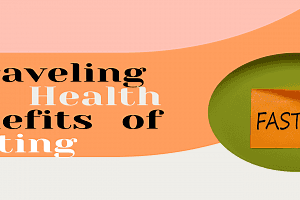Unraveling the Health Benefits of Fasting

Dr. Chirag Sethi* and Dr. Swarna Anchal**
*Director, Classic Fitness Academy, New Delhi.
**Technical Writer, Classic Fitness Academy, New Delhi.
There is a plethora of information regarding various forms of fasting and its health benefits. In fact, in recent years, internet searches using the terms "diet, fasting, intermittent fasting" had more hits than any other form of weight loss. On the other hand, the fact cannot be denied that we have not enough evidence-based data to support fasting and cannot be recommended for public health practice.
Fasting is an ancient practice followed in different patterns and all around the world. Fasting refers to the eating patterns that include the periods of eating and fasting for 16-24 hours at a time and also known as intermittent fasting (IF). During fasting, our body moves through various changes in our metabolism and hormone levels which are not only responsible for the metabolic changes but also attributed to some health benefits such as weight loss and fat loss. There are promising researches done on rats and it is shown that IF helps loses weight, keeping high blood pressure to normal, reducing cholesterol, and blood sugars. But in the case of humans, researchers have shown that IF is safe and exceptionally helpful. Many people find it difficult to fast as they cannot control hunger and cravings. The situation may worsen for people who are not enough aware of food quality, quantity, and nutritional values for health benefits.
In this article, we will discuss the different stages of fasting, changes that occur in the body during fasting, and its health benefits.
Stages of Fasting:
Fasting is a cyclic process and includes the following four stages. Different changes occur in the body during each stage as discussed below.
The stage starts from the first few hours after eating meal and our body digests the food and absorbs nutrients from it. Different people have different kinds of food choices but according to the number of carbohydrates in a meal, the blood sugar levels increases. If the carbohydrates are present in high amount then amounts of insulin are also increases. Insulin hormone helps the cells to uptake glucose molecules. During the metabolism of carbohydrates, extra sugar is stored in the liver and muscles as glycogen and can be converted back to glucose when our body needs them. The level of other hormones such as 'Leptin’ and ‘Ghrelin’ also change and depends upon the hunger status of a person.
During hunger, the Ghrelin level increases and stimulates the person to eat and its levels decrease after eating. Meanwhile, leptin has an appetite-suppressing effect and its level increased after eating.
Body transit into the early fasting stage after 3–4 hours of eating and can remain in this stage up to 18 hours after eating. During this phase, blood sugar and insulin levels start to decline and the body starts converting stored glycogen into glucose to use as energy for work and activities. As the stored glycogen is used as energy so, by the end of this phase, the body slowly runs out of liver glycogen stores and starts searching for another energy source, fats. Hence triglycerides from fat cells are broken down and can be used as an alternative source of energy. The body can also use amino acids and can convert them into energy but that is the last option when no other source of energy is available. Most of the intermittent fasting is between the fed state and early fasting state.
This stage lasts from about 18 hours to 2 days of fasting. During the stage, glycogen that is stored in the liver and muscles has been depleted, and the body starts breaking down protein and fat for energy. As a result, ‘Ketone’ bodies are produced and the body reached ‘Ketosis’, a metabolic state when the body uses fat as its primary source of energy. The portion size and composition of the meal and last meal play an important role here that how quickly the body enters a ketosis state. The fasting that has shorter fasting than 24 hours may not reach ketosis.
4. Long-term fasting state (starvation state)
Our body enters the long-term fasting stage if fasting is more than 48 hours, also known as the starvation stage. During this stage, insulin level continues to decrease and other ketone bodies such as beta-hydroxybutyrate level start to rise. To fulfill the energy consumption, kidneys start to generate sugar which also functions as fuel for the brain.
Fasting can help weight loss
The foods we eat pass our digestive system and are broken down by various enzymes in our gastrointestinal tract and finally end up in tiny molecules in our bloodstream. Carbohydrates with a high Glycemic Index (GI) such as simple sugars and refined grains (white flours and rice) are quickly broken down into glucose, which our cells use for energy. Glucose can only enter our cells when insulin (secreted by the pancreas) binds to their respective receptors on cells. If our cells don’t use it all then extra glucose is store in our body. Insulin brings the sugar into the fat cells and keeps it there which may convert to fats later on.
To lose body fat, avoid taking snacks between the meals thus resulting in decrease in insulin levels and our fat cells may release their stored sugar, to be used as energy. In this condition when our insulin levels go down, we lose weight. The entire science behind fasting is to bring the insulin levels down enough and for long enough so that we burn off our stored fat.
Fasting can be hard
Two different forms of fasting exist and these are (1) Fasting every other day (2) Eating less every day. Many people follow one of them as per their medical health, fitness, and time management. Initial human studies have shown that both worked equally for weight loss. So, eating less every day is not worse but far more uncomfortable for some people.
Researchers from the University of Alabama conducted a study with a small group of obese men with pre-diabetes. They divided the subjects into two groups:
(1) All meals were fit into early 8 hours of the day i.e. 7 AM to 3 PM.
(2) All meals spread out over 12 hours of the day i.e. 7 AM and 7 PM.
Both groups maintained their weight (did not gain or lose) but after five weeks, the 8 hours group had significantly lower insulin levels and considerably improved insulin sensitivity, as well as significantly lower blood pressure. The 8 hours group also had notably decreased appetite. Thus fasting is effective in losing fat and improving health. However, people with advanced diabetes or who are taking medications, people with a history of eating disorders like anorexia and bulimia, and pregnant or breastfeeding women should not attempt fasting unless under the close supervision of a physician or dietician who can monitor them.
Precautions
- Our metabolism has adapted to daytime food and nighttime sleeping i.e., a circadian rhythm. Night-time eating is well associated with a higher risk of obesity, as well as diabetes so try to avoid eating at night.
- Stick with the sensible, plant-based, whole grain, fruits, and veggies-rich meal.
- Include low-fat dairy and protein-rich products.
- Avoid all forms of processed food articles and drinks.
- Drink plenty of water.
- Light to moderate physical activity like walking, jogging, and yoga during fasting.
References:
(1) Anton SD, Moehl K, Donahoo WT, Marosi K, Lee SA, Mainous AG, Leeuwenburgh G, Mattson MP(2018) Flipping the Metabolic Switch: Understanding and Applying the Health Benefits of Fasting. Obesity 26(2):254-268.
(2) Halagappa VKM, Guo Z, Pearson M, Matsuoka Y, Cutler RG, Laferla FM, Mattson MP (2007) Intermittent fasting and caloric restriction ameliorate age-related behavioral deficits in the triple-transgenic mouse model of Alzheimer's disease. Neurobiological Diseases26(1):212-20.
(3) Hartman ML, Veldhuis JD, Johnson ML, Lee MM, Alberti KG, Samojlik E, Thorner MO (1992) Augmented growth hormone (GH) secretory burst frequency and amplitude mediate enhanced GH secretion during a two-day fast in normal men. Journal of Clinical Endocrinology and Metabolism74(4):757-65.
(4) Ho KY, Veldhuis JD, Johnson ML, Furlanetto R, Evans WS, Alberti KG, and Thorner MO (1988) Fasting enhances growth hormone secretion and amplifies the complex rhythms of growth hormone secretion in man. Journal of Clinical Investigation 81(4): 968–975.
(5) Martin B, Mattson MP,and Maudsley S (2006)Caloric restriction and intermittent fasting: Two potential diets for successful brain aging. Ageing Research Reviews 5(3):332–353.
(6) Mattson MP, Wan R (2005) Beneficial effects of intermittent fasting and caloric restriction on the cardiovascular and cerebrovascular systems. Journal of Nutritional Biochemistry 16(3):129-37.






